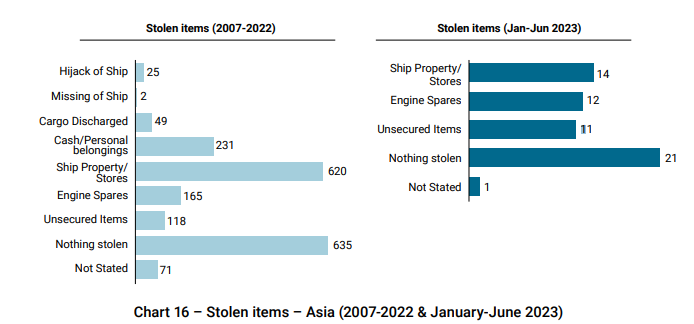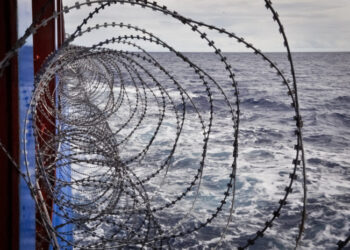In its Half Yearly Report 2023 report, ReCAAP Information Sharing Centre (ISC), provides an insight into the incidents reported in Asia during January-June 2023 compared to the trend of past incidents during the 16-year period of 2007-2022.
In particular, the analysis focuses on the number of perpetrators, weapons carried, treatment of crew, stolen items, type of ships boarded and time of the incidents.
Number of Incidents during 2007-2022 and January-June 2023
During 2007-2022, a total of 1,962 incidents (comprising 1,747 actual incidents and 215 attempted incidents) were reported in Asia. During this period, the number of incidents fluctuated over the years, with the highest number of incidents in 2015 (203) and the lowest in 2018 (76).
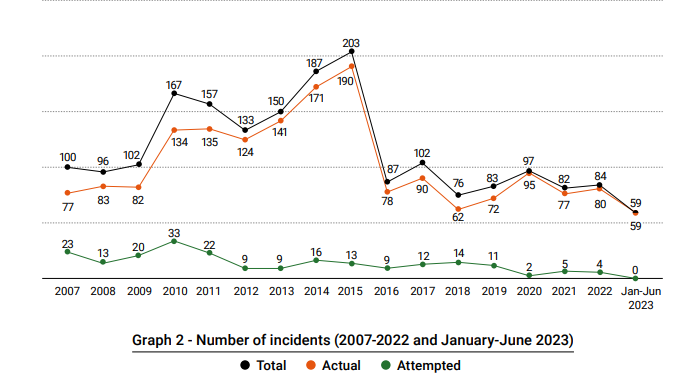
A total of 59 incidents were reported in Asia during January-June 2023. The incidents reported were consistent with the trend of past incidents during the 16-year period of 2007-2022, in terms of the number of perpetrators, type of weapons carried by perpetrators, treatment of crew and time of incidents. However, there was a deviation in the stolen items and type of ships boarded.
The characteristics of the incidents reported in Asia during January-June 2023 are as follows:
- 68% of the incidents were CAT 4
- 51% involved perpetrators in groups of 4-6 men
- 68% of incidents involved perpetrators who did not carry weapons or no information on the weapons carried, and 32% armed with knives, machetes and other weapons
- No injury sustained by crew in 92% of incidents
- 35% of incidents reported nothing was stolen, 2% reported losses cannot be ascertained
Type of items stolen: ship property/stores (24%), engine spares (20%), unsecured items (19%)
- 49% of incidents occurred on board bulk carriers, 22% on board tankers, 15% on board tug boats/supply vessels, 12% on board container ships and 2% on board fishing trawler
- 92% occurred during hours of darkness
Number of perpetrators
2007-2022. Among the 1,906 incidents, 628 incidents involved 4-6 men (33%), 518 incidents involved 1-3 men (27%), 181 incidents involved 7-9 men (10%), 138 incidents involved more than 9 men (7%), and 441 incidents had no information available (23%).
January-June 2023. Of the 59 incidents, 30 incidents involved 4-6 men (51%), 17 incidents involved 1-3 men (29%), two incidents involved more than 9 men (3%), one incident involved 7-9 men (2%) and nine incidents had no information available (15%). The details of the number of perpetrators involved in an incident is indicated in Chart 13 shown below.
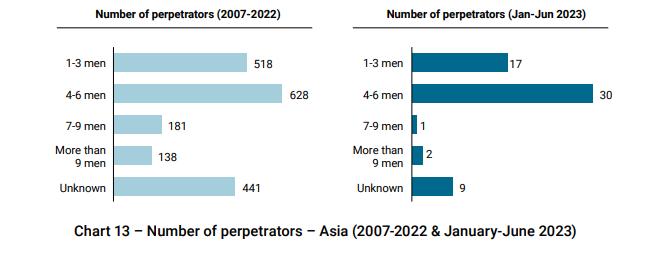
Type of weapons
2007-2022. Of the 1,906 incidents, 932 incidents had no information on the weapons carried by the perpetrators (49%), 614 incidents reported knives/machetes (32%), 190 reported guns and knives (10%) and 170 did not carry weapons (9%).
January-June 2023. Among the 59 incidents, 19 incidents reported that the perpetrators carried knives, machetes and other weapons such as adjustable wrench and spanners (32%), nine incidents reported the perpetrators did not carry weapons (15%) and 31 incidents had no information of weapons carried by the perpetrators (53%). Chart 14 outlines the types of weapons carried by the perpetrators.
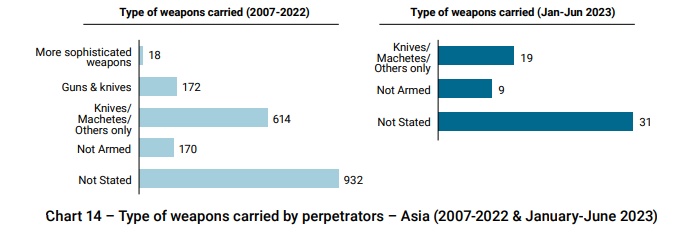
Stolen items
2007-2022. Of the 1,906 incidents, losses of ship stores were reported in 620 incidents (32%), losses of cash/personal belongings in 231 incidents (12%), losses of engine spares in 165 incidents (9%), losses of unsecured items in 107 incidents (6%), 71 incidents with losses not stated (4%) while 636 incidents reported nothing was lost (33%).
January-June 2023. Among the 59 incidents, 14 incidents reported losses of ship stores (24%), 12 incidents reported losses of engine spares (20%), 11 incidents reported losses of unsecured items (19%), one incident reported the type of losses could not be ascertained (2%), while 21 incidents reported nothing was lost (35%). Chart 16 shows the details of stolen items from ships.
